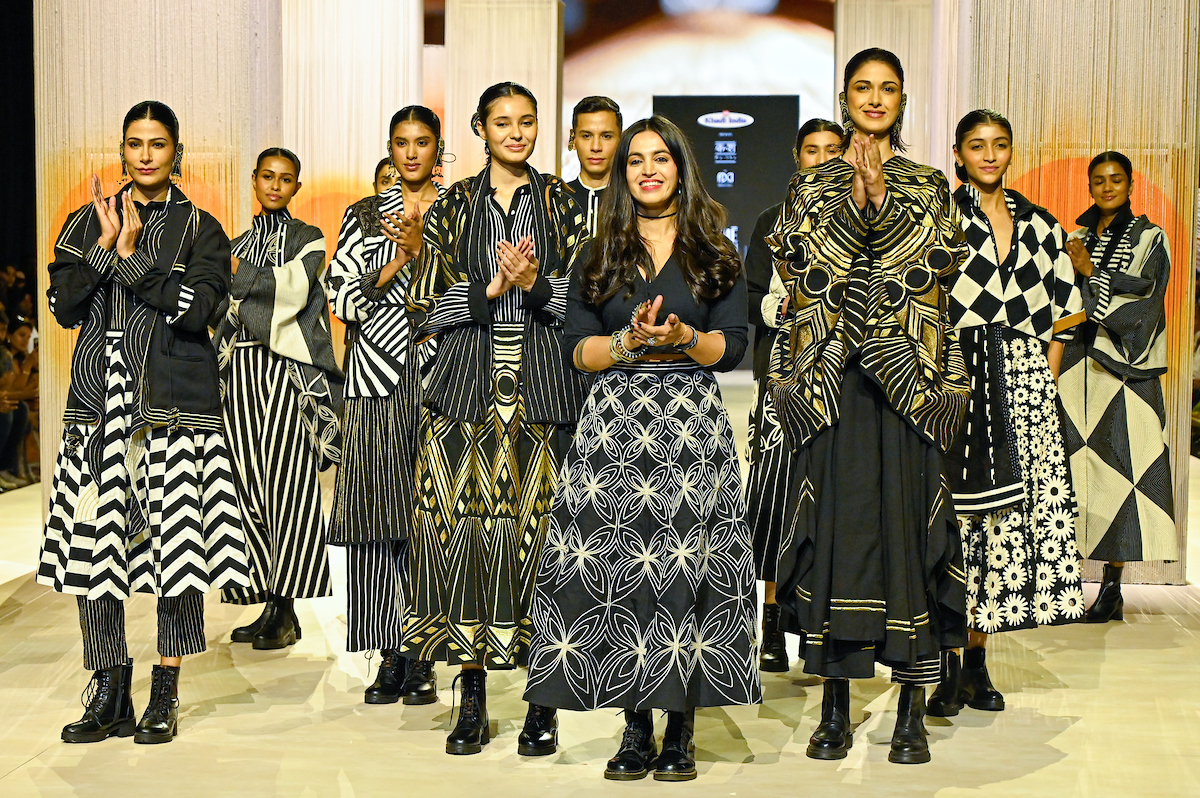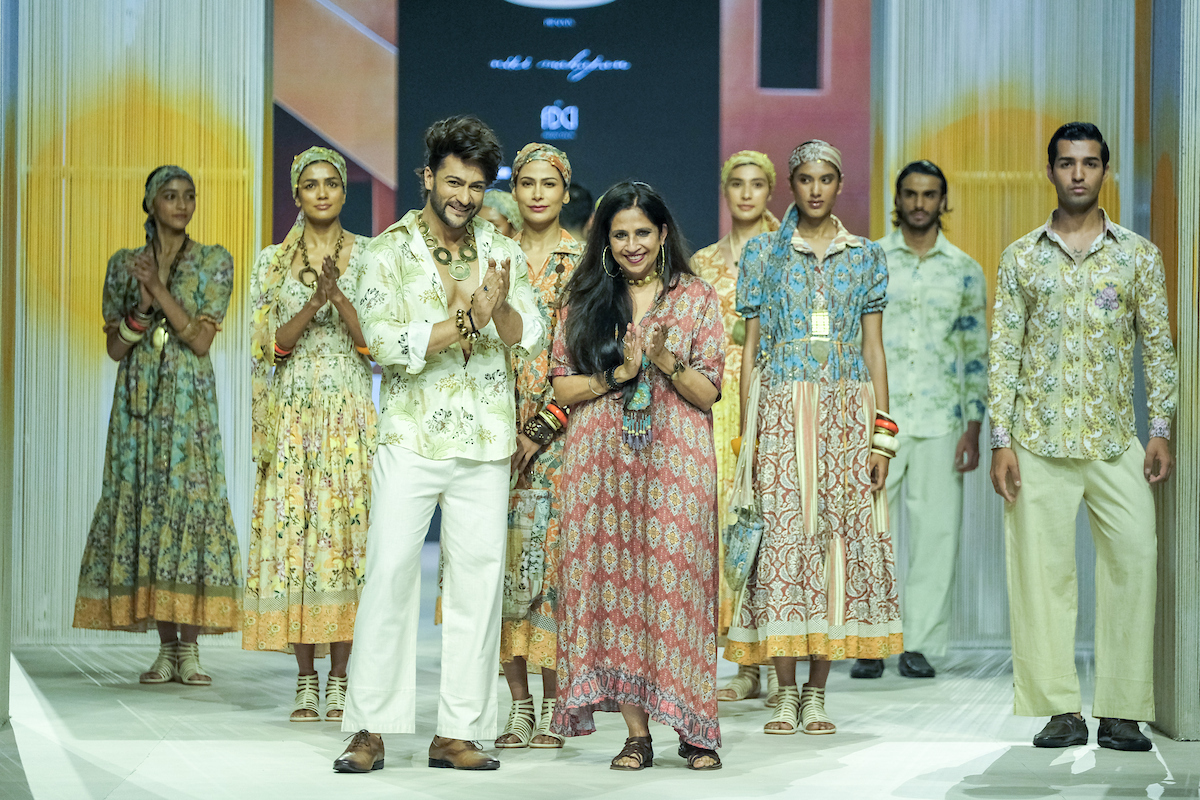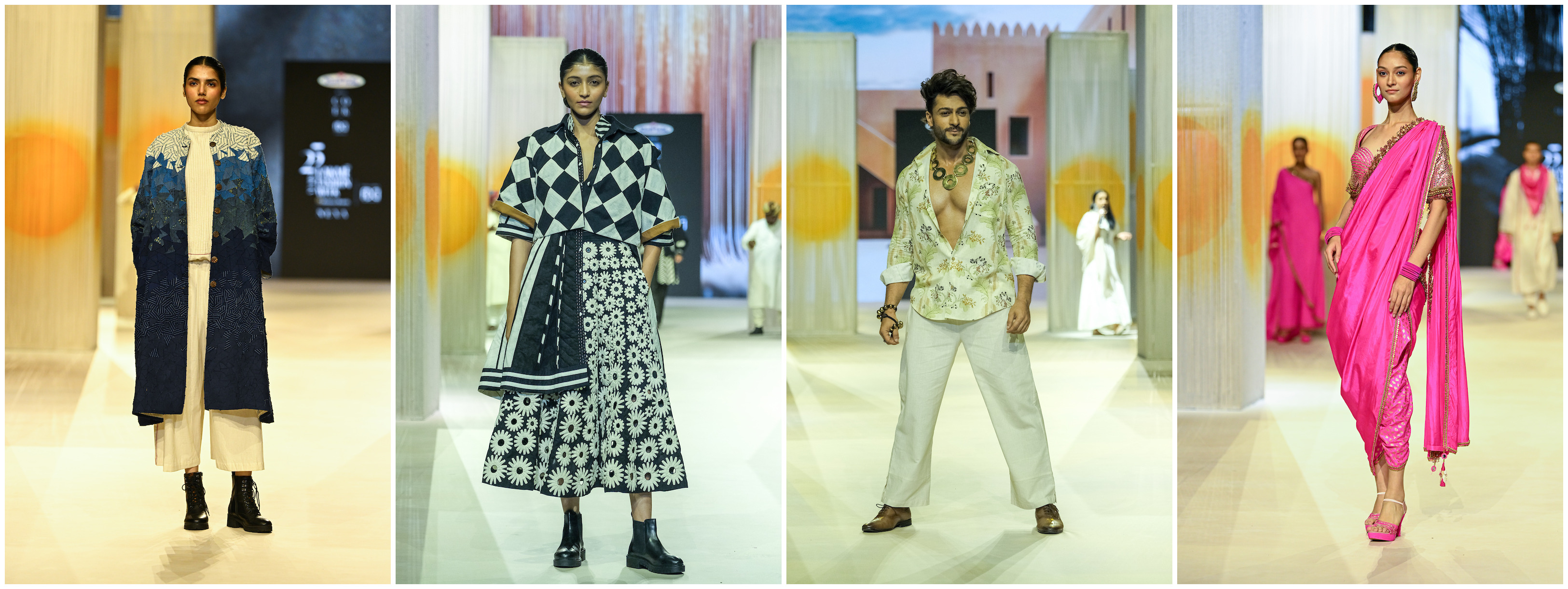KHADI INDIA LAKMĒ FASHION WEEK FDCI TEXTILES SUSTAINABILITY HERITAGE CRAFTSMANSHIP KARISHMA SHAHANI KHAN SAMANTAR II KALA COTTON NIKASHA TAWADEY MAHBOOB HAND-WOVEN NIKI MAHAJAN BAROQUE FRENCH BROCADES SHALIN BHANOT COEK KVIC NIFT HAN NATIONAL
MUMBAI, MAHARASHTRA, INDIA
By IFAB MEDIA - NEWS BUREAU - March 28, 2025 | 315 8 minutes read
The beauty of the timeless khadi fabric was brought to centre stage by five well-known designers who presented their creative visions for the popular fabric of India during the Khadi India show at Lakmē Fashion Week in partnership with FDCI. This event highlighted the Fashion Design Council of India’s commitment to promoting Indian textiles globally with Khadi – India’s most iconic fabric at the heart of the showcase.
Following the success of the Khadi showcase at Moscow Fashion Week (March 2025)—an initiative that further strengthens Khadi’s global appeal— the Council continued its mission of taking Indian textiles to the world.
“As Lakmē Fashion Week celebrates 25 years, we take great pride in leading multiple initiatives to promote Khadi both in India and worldwide. Khadi is not just fabric—it represents our heritage, sustainability, and craftsmanship. Showcasing it on global platforms is an honour and a matter of national pride,”said Sunil Sethi, Chairman, FDCI.
The ramp came alive with a modern interpretation of Khadi with the colourful, detailed, sharply constructed, silhouettes from Karishma Shahani Khan, Nikasha, Niki Mahajan and CoEk -Khadi India.
To the foot tapping beat of the melodious singers, Samandar Khan and Deveshi Sahgal, the show moved into a musical and fashion khadi extravaganza.
KARISHMA SHAHANI KHAN’S SAMANTAR II COLLECTION
The ‘Ka-Sha’ brand by seasoned designer Karishma Shahani Khan unveiled the “Samantar II” collection at Lakmē Fashion Week in partnership with FDCI. The collection drew parallels between what has been and what will return again. Karishma’s collection was an ode to her particular techniques, which she has uniquely made her own, butthis season with the use of Khadi and Kala cotton. The colour codes were however restricted to just black, white and gold for this collection. While the patterns developed were repetitive, they mirrored a certain gradient in nature.

The signature geometric elements were very much apparent for the appliqués, embroidery and patchwork as well as cording, zari embroidery and strips of embellishments.The inter layering of the garments was with natural and organic shapes that allowed Karishma to introduce innovative silhouettes in a new age format.
The layering, overlays, jackets (long and short),skirts, shirts, and pants were all comfort wear, with several having reversible options. The designing and tailoring were sharp, but kept totally deconstructed.
Bringing men's wear, which was inspired partially by women’s wear accents, the designer revealed that there was an interchanging and borrowing of creativity between the looks for men’s and women's garments.
The overall accent of the “Samantar II” collection by Karishma Shahani Khan for her ‘Ka-Sha’ label,revolved around relaxed, comfort wear with controlled volumes that ensured, the designs could be mixed and matched as per the wearer’s wishes.
NIKASHA TAWADEY’S MAHBOOB COLLECTION
There is no doubt that India’s most treasured fabric, khadi is crafted with love, heritage and skilled artistry. Nikasha Tawadey’s eponymous label, which was started in 2006, paid tribute to khadi with the “Mahboob” collection. “Mahboob” signifies the beloved, and for the ‘Nikasha’ label, the collection was a heartfelt expression that displayed amazing craftsmanship.
The khadi ensembles were dreamt up with the legacy of artisanal fashion, that was also merged skilfully with contemporary weaving stories. Nikasha is known for her fluid drapes that have a distinct feminine vibe about them, which was visible for her line of khadi creations. Her intricate detailing was evident on the rich hand-woven textures of khadi as her “Mahboob” collection redefined timeless elegance.

There was a grand blending of fashion nostalgia with modern spirit that made the “Mahboob” khadi collection a great fashion offering. Nikasha Tawadey’s creativity for her label ‘Nikasha’ ensured that khadi was not only perceived in its beautiful, organic form, but also as a modern, fashion, forward fabric from India.
NIKI MAHAJAN’S FRENCH TOUCH
One of India’s popular designers, Niki Mahajan, has been showcasing her fashion visions on the ramp since 1993. Her work with talented artisans from Bihar, Rajasthan,Assam and other parts of India have given an edge to her designing concepts. Niki Mahajan’s designs for Khadi brought the grandeur of Baroque and French brocades that were translated into prints on the raw, earthy, beauty of khadi.

The very colourful show was opened by the dapper and cool, popular TV star Shalin Bhanot, who made a sprightly entry in yellow and white abstract print shirt and cool white trousers.
Niki’s concept of merging baroque and European influences with khadi, proved to be a bold and unexpected fusion move. The very feminine line featured Niki Mahajan’s statement fluid silhouettes that floated down the runway on elegantly styled models.
The great mélange of history and craftsmanship unveiled a new dimension for the ensembles. The contrasting European patterns created a fashion melody when Niki balanced them with the raw organic textures of khadi that gave the collection a rich fashion direction. Detailing revolved around luxurious pleats and gathers that added a soft sophisticated elegance to the look.
Effortlessly wearable, Niki Mahajan’s khadi collection,with French accents, gave the ensembles a dramatic formal appeal.
THE COEK – KHADI INDIA COLLECTION
Khadi for contemporary elegance and fashion was reimagined by the Centre of Excellence for Khadi (CoEK), an initiative of the Khadi &Village Industries Commission (KVIC) and the National Institute of Fashion Technology (NIFT) at Lakmē Fashion Week in partnership with FDCI.
Khadi has always been more than just a fabric ever since it was promoted by Mahatma Gandhi. It has been a philosophic movement and a step towards sustainable fashion.
The hand spun; hand woven, beauty of khadi has a rich heritage that maintains minimal carbon footprint, thus making it an ideal offering for conscious global consumers.
The collection presented had design innovations from CoEK, which has worked closely with Khadi institutions around India. The women’s wear line was based on Indian craftsmanship and global sensibilities. The collection featured a variety of khadi fabrics that ranged from cotton to wool and then moved onto luxurious Eri silks. The fabrics were sourced from khadi institutes in Uttar Pradesh,Rajasthan, Gujarat, Tamil Nadu and Assam.
The relaxed fashionable beauty of the collection by CoEK – Khadi India was the highlight of the apparel that will not only be coveted by national fashion followers but global style trend setters.









